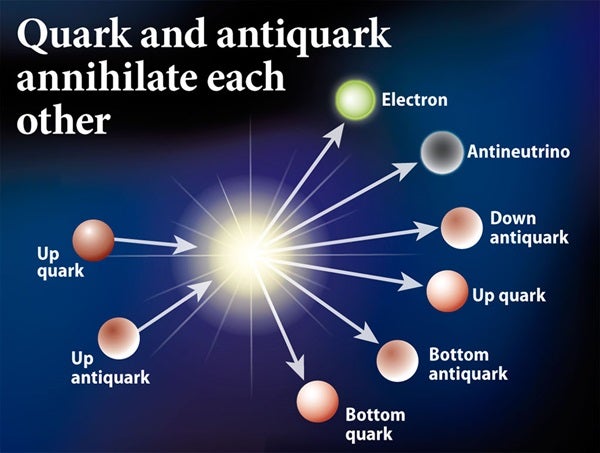Q: Could the energy produced during matter-antimatter annihilation in the early universe be dark energy? If not, where is that produced energy today?
A: Astronomers see galaxies flying away from each other faster than expected. Some sort of energy — dubbed “dark energy” because we cannot identify what it is — must be causing this repulsion. We know that dark energy composes an amazing 68 percent of the universe, so it produces an extremely big effect. Normal matter — like stars, gas, and planets — is only 5 percent of the cosmos.
Scientists believe that the laws of physics are constant everywhere and at all times. Decades of experiments have tested this principle and shown that it is valid. Therefore, we can use our current theory to predict what happened at the Big Bang, even though no one was around to observe the universe’s beginning.
We can study and measure matter-antimatter annihilations in high-energy accelerators. For instance, when quarks interact with antiquarks, we can measure the newly produced particles that have energy we can observe. Thus, the collisions aren’t creating dark energy (we can’t see dark energy; we can only detect its effect). Accelerator experiments also show no hint of dark matter — the mysterious mass that makes up 27 percent of the cosmos.
Physicists believe that the simplest explanation of a scientific question is often the best, so we conclude that throughout the universe, when matter collides with antimatter, the interaction produces the same energy we see on Earth. If the laws of physics are constant over time, we assert that when the cosmos was full of matter and antimatter, starting around one-trillionth of a second after the Big Bang, collisions between them produced the same energy we see and feel every day.
As the universe expanded and cooled, the collisions’ energy went right back to where it came from: matter, antimatter, and energy. For some reason, however, there was one slight asymmetry; the process created more matter than antimatter, which is why we see only matter today. The early universe’s antimatter and matter simply converted into our matter. Thank goodness, too — an astronaut would not want to meet up with antimatter debris.
Lawrence Berkeley National
Laboratory, California










